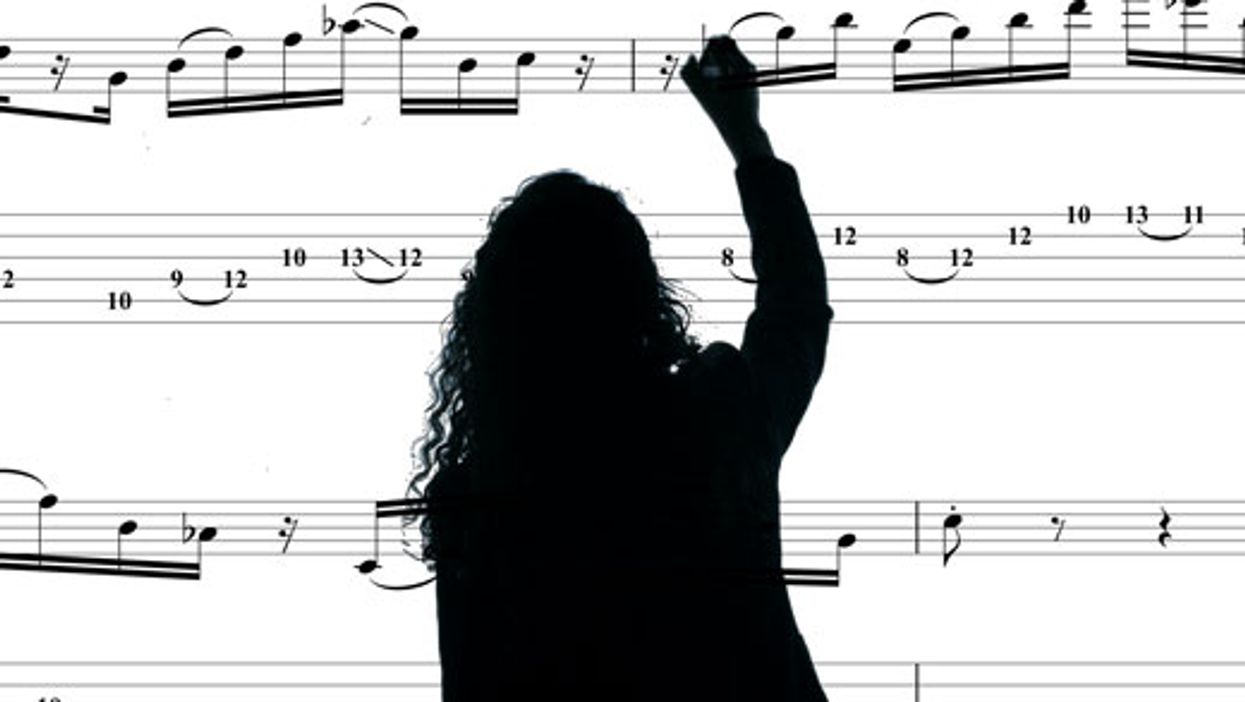| More Detailed Diminished Part I Part II Part III Part IV Part V |
Diminished Forms
The difference between the Locrian/diminished scale and the Aeolian/minor scale is a b2 and b5. Since the difference between the Phrygian and Aeolian scales is only the b2, the important difference when comparing Locrian and Aeolian is the b5.
There are three forms of a diminished chord/arpeggio:
• The triad: 1, b3, b5
• The half-diminished (also known as a minor7b5): 1, b3, b5, b7
• The fully diminished: 1, b3, b5, bb7
The triad and fully diminished chords/arpeggios have an equidistant quality: the distance between the tones is always a minor third, or three half-steps. Sometimes there will be a tri-tone—two minor thirds, or six half-steps—in the middle of the chord. It’s called a tri-tone because, if you take the b5 interval—say, a D (root) on the 5th string, 5th fret, and an Ab (b5) on the 4th string, 6th fret—and move them a minor third in opposite directions, you’ll get the same note. The D up three frets is F, and the Ab down three frets is also F. This works on all b5 intervals, and you can move either note up or down (as long as they’re moving in opposite directions) and it works the same way—you’ll get either an octave or a unison.
When a chord/arpeggio has the equidistant quality (augmented and diminished), any note can be the root. For example, with an E diminished arpeggio—E, Bb, Db, G (fully), E-1, Bb-b5, Db-bb7 and G-b3—you can change the root and still have the 1, b3, b5, bb7 formula:
• Bb root: Bb-1, Db-b3, G(Abb)-bb7, E-b5
• Db root: Db-1, G-b5, E(Fb)bb3, Bb-bb7
• G root: G-1, E(Fb)-bb7, Bb-b3, Db-b5
This works on the diminished triad and the fully diminished chords, but not on the half-diminished. The half-diminished chord breaks the constant minor third sequence: 1 to b3 (minor 3rd), b3 to b5 (minor 3rd), and b5 to b7 (major 3rd). The equidistant quality is lost with the major third.
With that, let’s focus first on the diminished triad (1, b3, b5) and the fully diminished chord (1, b3, b5, bb7). We’ve already established that these two chords have the equidistant quality and that any note can be the root. When that happens, the arpeggio can be moved a constant distance (in this case, three frets) and it will repeat itself.
Applying the Idea
Now that you know the important forms, let’s talk about how to use them—starting with the word “normal.” Normal means something different in music than in other contexts. Normal in Western music means “its role in the Ionian/major scale.” What is the role of a diminished chord/arpeggio in the major scale? It’s the 7th scale degree harmonized with a 3rd and a 5th. It’s very dissonant/unstable, therefore it “requires” resolution to consonance/stability. As a matter of fact, anything in Western music considered unstable requires resolution to stability. This concept is also known as “tension and release,” and is critical in the construction of an effective piece of music.
If we look at the major key, we notice that the diminished chord is resolved by moving up a half-step to a major chord vii°- I. That movement is considered the “normal” resolution of the diminished chord, again, because that’s what happens in the major scale. Since any note in a diminished chord/arpeggio can be the root, it can resolve to four different places. For example, the E diminished chord would resolve to an F major. The same chord is also a Bb diminished resolving to B (Cb), a Db diminished resolving to E, and a G diminished resolving to Ab. That means the diminished chord is a great tool for creating tension (instability) and for modulating to a different key.
Here are some of the examples we saw in the last column (Detailed Diminished II), but with a “normal” resolution.
Listen |  |
Listen |  |
Listen |  |
Listen |  |
OK, guys and gals, we’re gaining momentum in our study of the strange and beautiful diminished idea. Study the lessons in this series carefully, and you’ll build a solid foundation in your understanding of the diminished concept and how to apply it to your everyday guitar playing. But stay tuned, because we’re going to go deeper into this study and give you the tools you need to feel confident and comfortable using diminished lines in your playing. Thanks for logging on and tuning in, and I’ll see you next month. Feel free to contact me with any questions you may have by email or by leaving a comment below.















